Capping
A blend terminates when the figurative rolling ball does not roll onto any of the new entities it encounters, but attempts to trim the blend face to the body. Normally, this involves intersecting the blend surface with existing body faces, or possibly the extension of existing body faces. This process is referred to as capping. When a cap terminates a blend, it is referred to as an end cap.
Capping may not always terminate the blend. The cap may not cover the end of the face, but merely a side of it, with the original blend face continuing afterwards. Such a cap is called a side cap.
Special Cases
The capping algorithm is robust and can handle a large number of cases. However, for a few simple blend cases, the capping algorithm is unnecessarily complex and therefore slower than necessary. With performance in mind, a special case capping algorithm is used to handle the following two cases differently:
- The most simple mixed convexity capping case (refer to Figure. Simple Mixed Convexity)
- The mixed convexity case with the capping intercept not on a body edge (refer to Figure. Capping Intercept Not on Edge)
The special case algorithm first identifies these two cases and then calculates the capping surface and the edges that are to be used to close off the blend. The capping face topology is then built and appended to the blend sheet. Attributes that aid the Booleans in blend stage two (by avoiding the recalculation of the intersections) are then added to this sheet body. On average, this algorithm results in a twofold (2X) time improvement though only over the time spent in capping.

Figure. Simple Mixed Convexity

Figure. Capping Intercept Not on Edge
Edge-Face Blend Instead of Side Cap
Standard blending can sometimes use edge-face blends as an alternative to creating blend side caps. The preference for the edge-face blend alternative can be specified by supplying the extra final argument to api_set_const_rounds as bl_how_roll_on. The default value for this argument prefers side caps, thereby maintaining the behavior of previous versions of ACIS.
The following figures illustrate the difference between a blend with side caps and a blend in which edge-face blends are used. In Figure. Side Caps, the blend has side caps. In Figure. Edge-Face Blends Instead of Side Caps, edge-face blends are used instead of side caps, and the straight edges that bound the planar face on which the blend rests are preserved.

Figure. Side Caps

Figure. Edge-Face Blends Instead of Side Caps
If the algorithms determine that the edge-face alternative may not work, a side cap is used, regardless of the setting of the extra argument to api_set_const_rounds. For example, if the sequence of edges where the side cap would normally occur contains non-tangent meeting edges, the side cap is used anyway. If an edge-face blend is used, and the other side (where the blend still rests on a face) requires a side cap, the blending algorithms consider using an edge-edge blend. This feature currently has limited capability.
In the following figure, edge-face blends are used wherever possible, and a side cap is produced where edge-face blends were not.

Figure. Edge-Face Blends and Side Cap
[Top]
© 1989-2007 Spatial Corp., a Dassault Systèmes company. All rights reserved.